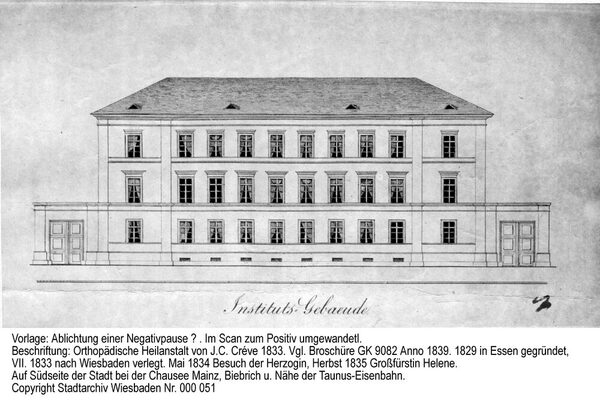Orthopaedic sanatorium
The orthopaedic clinic was founded by Johann Baptist Carl Crevé, who was born in Mainz in 1789 and received his doctorate in medicine in Heidelberg in 1823. He moved his practice for joint and muscle patients from Frankfurt to Wiesbaden in 1833. In 1836, he moved into a three-storey brick building with a spacious courtyard and large garden at Rheinstraße 35/37. The 33 rooms and halls offered space for 50 mostly young patients, who mainly suffered from back pain.
Ten years after the institution opened, Crevé sold the building to the ducal domain treasury for 64,000 fl. The originally planned establishment of a residence for the widowed Duchess Pauline Friederike zu Nassau did not materialize, so the operation of the orthopaedic sanatorium could be continued on a smaller scale. After Duke Adolph's wedding in 1844, an orthodox house chapel with a sumptuously furnished lounge was set up for his wife, Duchess Elisabeth zu Nassau, a niece of the Russian Tsar, by combining three halls on the second floor of Crevé's house. On the upper floors, apartments were created for a priest and his family, the choir and various servants. In 1852, Tsarina Alexandra visited the house chapel, which ceased to exist after the early death of the Duchess.
The building was subsequently used as business premises for the ducal state government and as a Prussian administrative building. After the Second World War, it served as accommodation for American troops.
Since it was handed over to the state of Hesse in 1954, the Crevé House has housed the Hessian State Statistical Office.
Literature
Eichler, Joachim: The history of orthopaedics in Wiesbaden. In: Orthopädische Praxis 4/XI, Baden-Baden 1975.
Schüler, Winfried/Sprandl, Manfred: From the Orthopaedic Sanatorium to the State Statistical Office. The eventful fate of the house at Rheinstraße 35/37 in the mirror of Wiesbaden's city history 1836-1996. Ed.: Hessisches Statistisches Landesamt, Wiesbaden 1996.
